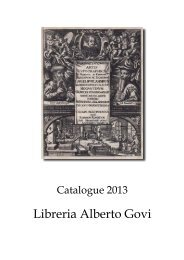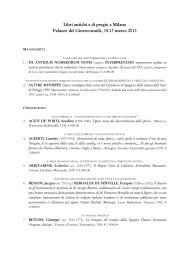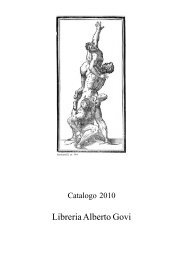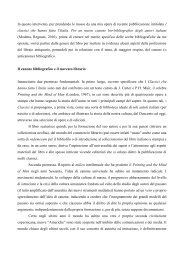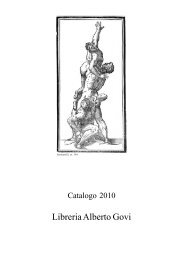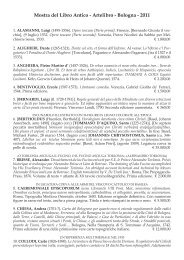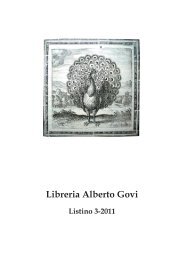List 4-2013 - Libreria Antiquaria Alberto Govi
List 4-2013 - Libreria Antiquaria Alberto Govi
List 4-2013 - Libreria Antiquaria Alberto Govi
You also want an ePaper? Increase the reach of your titles
YUMPU automatically turns print PDFs into web optimized ePapers that Google loves.
activities of the Accademia Fiorentina, among which should be mentioned Gli spiriti folletti (1546) and the Prose antiche di Dante, Petrarcha<br />
e Boccaccio (1547). In 1548, after the failure of his printing house, Doni broke off his relations with the Florentine milieu leaving Florence once<br />
and for all and, after a violent quarrel whose reasons remain obscure, ending his personal relationship with Domenichi.<br />
Back in Venice, Doni edited the first Italian version of Thomas More’s Utopia, translated by Ortensio Lando (1548). In 1549 his eldest<br />
son, Silvio, was born from an extramarital relationship with Lena Gabbia; to him Doni dedicated the Epistole di Seneca ridotte nella lingua<br />
toscana, issued in the same year. This is the first example of Doni’s penchant for plagiarism, since what he actually did was to publish under this<br />
title his own adaptation of Sebastiano Manilio’s translation of Seneca’s Moral Epistles (1494).<br />
Meanwhile, he had begun a close collaboration with the printer Gabriele Giolito with the publication of the Disegno (1549), a book concerned<br />
with the primacy of figurative art. In 1550 Giolito published three further volumes by Doni: Fortuna di Cesare, Prima Libraria, and<br />
Medaglie.<br />
In his writings from 1549 onwards Doni often mentions the Accademia Pellegrina. However, this is neither the name of an existing institution<br />
(as it was believed until recently), nor the designation of a project for the creation of a new community of intellectuals; Doni’s Accademia<br />
Pellegrina is simply a literary fiction and an important element of the setting of his works. Ercole Bentivoglio, Titian, Francesco Sansovino,<br />
Lodovico Dolce, Pietro Aretino, Francesco Marcolini, and other alleged members of the Accademia often appear as characters in, or even coauthors<br />
of, Doni’s output.<br />
Doni’s most productive period coincided with the years<br />
1551-1553, when he was a collaborator of the printer Francesco<br />
Marcolini, who during this triennium printed many of<br />
Doni’s major works: the Seconda Libraria (1551), the Zucca<br />
(1551-52), the Moral Filosofia (1552), the Marmi (1552-53),<br />
the diptych Mondi-Inferni (1552-53), the Pistolotti amorosi<br />
(1552), a collection of letters written by various fictional lovers.<br />
In 1555 Doni suddenly left Venice and went to Urbino,<br />
where he wanted to obtain the patronage of Duke Guidobaldo<br />
II della Rovere with the aid of Pietro Aretino. Aretino,<br />
however, refused, and to take revenge for what he considered<br />
a betrayal, in 1556 Doni wrote a very aggressive book, the<br />
Terremoto (Earthquake), in which he predicted that his former<br />
friend would die before the end of the year – exactly as<br />
happened. In 1556 he also published Le Ville, a work devoted<br />
- 18 -



